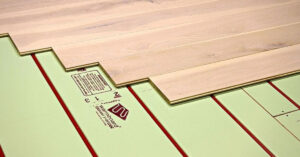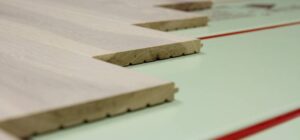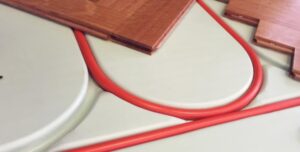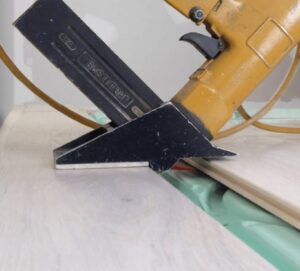Can You Install Hardwood Floors Over Radiant Floor Heating?
Posted: January 20, 2025Author – Ryan Palma Owner/CEO Sustainable Lumber Co.
Click on these links to view our extensive line of sustainable hardwood flooring. Email us for a pricing quote or call us at 406-642-7120.
We often get asked whether you can install hardwood flooring over hydronic heat, radiant heat, and in-floor heating systems, and the answer is Yes! We recently worked with a customer who was installing our hardwood flooring over the radiant heated floor system, Warmboard, and found some great installation information on their website. If you’re considering using Warmboard, you can view the original content on their website here: Warmboard; or read below, as we have included some information for your convenience.
Hardwood recommendations
Solid Hardwood
Solid, sawn, hardwood planks have been an integral part of residential architecture for over 400 years. Since 1998, over 40 million square feet has been successfully installed over Warmboard. The long documented history of hardwood combined with our decades of experience tells us that traditional 3/4″ solid plank flooring is the gold standard and accordingly, that is our strong recommendation.
All wood products expand and contract with changes in humidity. Solid plank wood is naturally monolithic and expands and contracts most evenly. When these dimensional changes do occur, cupping, crowning, and gapping at the edges may result. These changes are inherent to all wood flooring, regardless of the heating method. To minimize such dimensional changes, especially as humidity varies throughout the seasons, we also recommend quartersawn and/or rift cut planks due to their stability.
To further limit dimensional movement, ensure the hardwood has the proper moisture content at the time of installation. A good hardwood installer will know the ideal range for your geographic region (moisture content should be at the low end of this range). A moisture meter is required to determine when that moisture percentage is achieved.
Engineered Hardwood
Numerous engineered flooring products have been developed in recent years. With each product comes variations in material, assembly method, dimensional stability and overall quality.
Warmboard is unable to test every iteration of these products and therefore cannot express an informed opinion on how variations in humidity may impact their dimensional stability. We leave it to the consumer to do their own due diligence to determine any particular engineered product’s suitability for their project.
Moisture Content
All wood products expand and contract with changes in humidity. When these dimensional changes do occur, cupping, crowning and gapping at the edges may result. These changes are inherent to all wood flooring, regardless of the heating method. To minimize such dimensional changes, especially as humidity varies throughout the seasons, hardwood flooring should only be installed if it’s less than 8% moisture content. A moisture meter is required to determine when that moisture percentage is achieved.
Thickness
Many mistakenly believe that a radiant floor cannot have 3/4″ thick floor coverings. This thinking is based on a theory that the resulting higher R-value prevents the system from adequately heating the space. This may be true for low conductivity radiant panels, but not Warmboard. Apart from the fact that thicker hardwood, all things being equal, is better quality, its increased R-value causes more even heat across your floor with the result that your feet will not be able to tell where tubing is and isn’t. With thinner material, the temperature variation across the tubing is increased causing what is known in the radiant industry as “striping” which makes your floor less comfortable. And comfort is the primary reason for Warmboard’s existence, which is why we recommend using 3/4″ hardwood over our panels.
Acclimation
Before the hardwood is on site, ensure the interior plastering is complete (and dry), and that the radiant system has been operating for a couple weeks in order to reduce any excess moisture from the Warmboard panels. In some locales, you may need to operate the air conditioner simultaneously with Warmboard to lower the indoor humidity. The hardwood should experience consistent, low humidity once on site.
Consider any moisture or humidity intrusion that may take place in the future, such as a crawl space beneath the Warmboard panels which could be dry in the summer and experience water intrusion in the winter. This could cause large humidity swings and excess movement of the hardwood flooring.
Once the interior space is properly conditioned to the desired relative humidity, bring in the wood planks and sticker them – pulling the planks out of their boxes and setting them up so air can circulate around them.
Prior to flooring installation, the moisture content of Warmboard-R should be 12% or less. The moisture content of the finish hardwood should be between 6-9%, though this will vary by climate zone. Be sure to discuss this with your flooring installer.
It will be difficult to get a moisture reading from Warmboard due to its aluminum surface, so we a moisture meter with insulated contact pins and hammer probe. The Delmhorst J4 and J2000 models (delmhorst.com) are good options, and can be upgraded with pins and hammer probe.
Operating the System
Circulate warm water under the newly installed floor for a few days before gradually bringing the water temperature up to the designed set point. For example, start with 100ºF, then increase to 120ºF. Finalize the set point according to the needs of the structure.
Ideally, the heating system should use “Indoor Reset” or another type of reset control strategy. “Reset” is a system for automatically resetting boiler temperatures (up or down), to better meet changing heat loads. This is an excellent strategy for hardwood floors.
Acclimation Recommendations
- It is ESSENTIAL to acclimate wood flooring prior to installation. Acclimation time can vary by season, but two weeks is recommended.
- Keep low moisture levels in the hardwood to ensure long term stability. Maintain an indoor ambient temperature between 60-80˚F (15-26˚C), and keep the humidity between 30-50%.
Solid Wood Flooring Installation Recommendations
- It is essential to lower the moisture content of your hardwood prior to installation.
- Warmboard’s aluminum surface acts as a vapor barrier – no additional vapor retarder is required.
- Wood flooring can be installed directly over the Warmboard panels.
- When installing hardwood parallel to the tubing, rip the first plank at an appropriate width to create a nailing pattern which will avoid the tubing at all T&G locations.
Warmboard Approved Adhesives
- Bona R850T, R851, R859
- Bostik’s BEST, BST, Climb, EFA+, GreenForce, HDAC, ProCure, Pro-MSP, Ultra-Set SingleStep 2,Vapor-Lock
- Mapei Ultrabond Eco 975, 980
- Sikabond T-35 and T-55
- Stauf Adhesives PUK-455 Wide Plank Adhesive, PUM-950 Power Mastic
- Titebond 771, 811, 821
- Wakol MS 230, MS 232, MS 260, MS 262, MS 290, MS 292, MS 245/246, PU 224, PU 385
Warranty letters from these companies are available upon request.
How To Lay Wood Flooring Over Underfloor Heating: Installation Methods
Nail Directly
Installing hardwood perpendicular to the tubing pattern is the best method as it allows you to see the tubing and avoid damaging it. Tongue nail at a 45º angle at 6″ on centers and use 2″ flooring nails.
Occasionally, plank flooring may need to run the same direction as the tubing, and nailing the plank could cause tubing damage. Should this occur, DO NOT nail – either glue with an approved adhesive or face nail the plank. While the planks can be successfully nailed down parallel to the tubing
pattern, this method may require extra labor. Strategic planning with the layout can avoid face nailing and gluing in many locations.
Nail and Glue Directly
Aside from the glue itself, you do not need to install additional material between the Warmboard panel and the hardwood.
Installing hardwood perpendicular to the tubing pattern is the best method as it allows you to see the tubing and avoid damaging it. Tongue nail at a 45º angle using 2″ flooring nails at 6″ on center.
Occasionally, plank flooring may run the same direction as the tubing, and nailing the plank could cause tubing damage. Should this occur, DO NOT nail – the glue will successfully bond the plank to the Warmboard panel.
Glue Directly
Aside from the glue itself, you do not need to install additional material between the Warmboard panel and the hardwood.
- When installing hardwood parallel to the tubing, rip the first plank at an appropriate width to create a nailing pattern which will avoid the
tubing at all T&G locations. - ONLY use approved adhesives listed in the guide. Failure to use approved adhesives will void any product warranty.
Contact Us
Our knowledgeable and educated staff is here to answer any additional questions you may have. Please call us today for a free quote: Ph# 406.642.7120 or click here to submit an inquiry online. We look forward to working with you on your next project!




